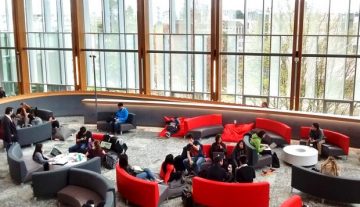
Capstone team creates interface to help the Nest become one of the most sustainable buildings in North America
Client: Campus + Community Planning, AMS Sustainability, Akshiv Bansal, Sustainability Projects Coordinator
Faculty Supervisor: Paul Lusina
Capstone Team: Micheal Griffin, Euan Chow, Anna Gudimova, Yuxin Xu (Eugene) and Meng-Yeng Lee (Dan)
UBC’s Alma Mater Society is excited to put the new student union building, through its paces. The architects used lots of innovative, green strategies in the design and now it’s time to see how sustainable the community can make this huge public building.
The Nest is well insolated, making temperature regulation easy in any weather. The building is also designed to make the most of the principle that hot air rises to circulate air through the entire building, known as passive air-conditioning. To conserve water, the plumbing uses grey water in toilets and collects rainwater for landscaping.
The architects did a great job, but the AMS doesn’t want to stop there. One of the most influential factors in green building design is human behavior and for human behavior to change there has to be feedback; that’s just basic learning theory. The next step is to collect, integrate, visualize and communicate all of the information the building is capable of providing so people can learn from the building.

This capstone project collects all the various sensors for regulating the building into integrated databases on a single, online server. The data can then be sent to the dashboard, soon to be installed in the Nest’s Sustainability Centre. The dashboard will let students know about positive or negative trends for things like waste recycling and compost. Through the dashboard, students will also be able to research their own projects on, for example, gas and water use or rainwater collection.

“I chose this project because I knew it could impact students for years to come. I wanted to provide something that will be used to reduce our carbon footprint on campus – which is something I hope to contribute to in my career once I graduate.” Micheal Griffin
The capstone team had to do lots of work on the back end, integrating the databases into one location to get this project to work. Initially the majority of the data was either unreadable, or unable to be transferred. The sensors were designed to regulate the building but not to display the activity to the building’s users.
Green buildings need to communicate with their occupants to really reach their potential. The interface will help students recognize the contribution they make to the building’s day-to-day energy and resource use and help UBC reach our aggressive sustainability targets. Hopefully, along the way, the Nest will also receive LEED+ Platinum certification, which is the highest sustainable building status in North America.
Find out more:
